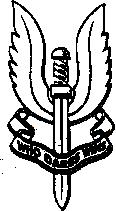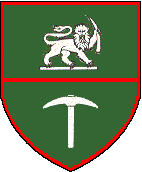The SAS Home Page Rank Structure and Badges of Rank SAS Roll of Honour Honours and Awards Army Home Page
One of the minor puzzles that has always dogged me as a former member of the SAS was the name of the unit. When I first arrived in Rhodesia in September 1977, I signed on the dotted line for a three year hitch and was sent to Old Cranborne to 'C' Squadron Rhodesian Special Air Service Regiment. In those days 'the Squadron' was hidden behind 2 Brigade Workshops and housed in a combination of old wooden and tin huts that looked like something from a movie set for a western. After my less than enthusiastic welcome by Squadron Sergeant Major Peter Allen, I was put on permanent guard and ditch digging duties until my Recruits Course came up. Being reasonably resilient, I was able to put up with it and soldiered on, digging ditches for Training Troop, going on resupply runs to the troops in the bush and generally trying to stay out of "Snake" Allen's way until January, 1978 when I began training with NS Intake 160.
Being a student of history and quite taken with the fact that I was now part of the famed SAS, I was intrigued by the name of unit. 'C' Squadron, huh? What happened to the rest of the unit, what about 'A' and 'B' Squadrons? I wasn't about to go up to "Snake" Allen or Major Robinson to ask them as they had both been rude to me on than one occasion.
During my Recruit's course we were required to learn the history of the Regiment, although it dealt with the founding of original 'L' Squadron in Egypt in 1941, and the role of 'C' Squadron in Malaya. The Regiment's original name must then have been 'C' Squadron, 22 SAS Regiment. I somehow got it into my head that the name had perhaps been changed after UDI, and the '22' figures somehow dropped. At end of my recruit's course, with Selection and my Para course behind - me, the SAS changed from a Squadron into a Regiment. I was never sure what this really meant in practical term, except that instead of being in a Squadron, I was now in a Regiment, and my Troop, 'A' Troop, was now 'A' Squadron. Most of the guys I did Basic Training with went to the newly formed 'C' Squadron as did some of the NCOs and men from the other two Squadrons. As far as the name change, I found out about it from a notice on the bulletin board that was outside of the Troopie's mess. At the time I thought that perhaps I should steal this minor piece of military history as I knew that it would be thrown away. It basically stated that 'C' Squadron was no more, and that the unit was now to be known as 1 (Rhodesian) Special Air Service Regiment. I liked the tidiness of the name, although the fact that "Rhodesia" was in brackets should have made me realise that it was thus well placed to be quietly dropped when and if the changing political situation required. Well, it was. The 'Squadron' became plain old 1 SAS, the Rhodesia Herald became the Herald and for a while we wondered if the RLI would become the Zimbabwe European Rifles. The SAS was ultimately disbanded in 1980, along with the RLI, no one seeing fit to test the theory of how workable a 'ZER' might have been in the new Zimbabwe.
None of the information I had seen or heard about the origins of 'C' Squadron `seemed to be consistent from one source to next. Even the Malayan Emergency, which gave birth to the Regiment , has been dealt with only briefly by historians and then only in terms of the pioneering of some military techniques.
In 1961 the government of the Federation of Rhodesia and Nyasaland decided to raise what became the Rhodesian Light Infantry and the SAS. From documents that are at the Public Record Office, the problem of what to name the new SAS 1 unit seems to have first come up when Lieutenant Colonel West, who was Senior Army Liaison Officer at Rhodesia House in London, wrote a letter on January 20th, 1961 to the Under-Secretary of State at the War Office, informing him that the new Rhodesian SAS Squadron was due to be formed shortly, that the Rhodesians intended to call it "C (Rhodesia) Squadron, 22 Special Air Service Regiment", and was this all right?
The first British reaction that as far as they were concerned this was fine. An internal document of the 24th of January stated that
the Rhodesian Squadron "...though part of the Rhodesian Forces, should form an integral part of 22 SAS Regiment, and should train with them."
However, a subsequent letter stated that "...we are doubtful whether this Rhodesian Squadron can remain an integral part of 22 SAS Regt.
whilst remaining part of Rhodesian forces."
"We suggest that in order to save complications, it might be better for them to be affiliated to 22 SAS Regt., in the same way as other Commonwealth
Regts are to British Regts." The matter was becoming complicated and began to generate more paper work at the War Office. Another document
dated the 3rd of February outlined the legal position of the Rhodesian Armed Forces vis-a-vis the British Armed Forces and the condition for
it to become a part of 22 SAS when it was deployed with them.
It also stated that the SAS Squadron which is to be raised by the Government of the Federation of Rhodesia and Nyasaland will be a
unit of a colonial force and not part of the regular (British) forces. Under the Federation Defence Act 1955 the Minister of Defence of the
Federation has to determine the style and designation of the unit and I feel that he cannot designate it as being a Squadron of 22 SAS
Regiment. You will appreciate that the latter is a corps of the (British) regular foroes. The practical solution would seem for the
unit to be called "The Rhodesian Special Air Service Squadron".
Another internal War Office document of the 15th of May 1961 deals with the legal as well as the political question of the
Squadron's name. It was for legal reasons that it was decided the name of this Squadron should not include mention of 22 SAS.
"The Rhodesian Squadron is a colonial unit raised by the Government of the Federation under the Federation Defence Act, 1955." Therefore it
could not be made part of the UK regular forces which would have been the effect had it been made a Sqn of 22 SAS. You will also recall that
the title was being decided at the same time as KINGFISHER was being planned. The political repercussions of the Rhodesian SAS Sqn, being
part of 22 SAS could be far reaching."
What exactly the writer meant by the last sentences is not clear, but the writer went on to try and define a role for the Rhodesian SAS within the
context of the Middle East or NATO.
"We agree that the Sqn, should be included in the UK ORBAT. The question is how..perhaps the best solution
is for the Sqn, to be made part of the Middle East Theatre Reserve on call to the C-in-C."
Presumably this occurred when 'C' Squadron was deployed to Aden with 22 SAS in 1962.
None of this, however, resolved the-question of a name for the Squadron. On the 27th of February Lt. Col. West wrote back to the War Office to say that "the
figures '22' should be omitted from the name of the Rhodesian SAS Squadron and the correct title will thus be: C (Rhodesian) Squadron, Special Air Service Regiment."
However, another short letter came from the War Office which decided the issue once and for all. After stating that the SAS was a Corps of
the Regular British Army and Rhodesian use of title SAS "...might lead to confusion.", went on to say:
"Should the word Rhodesia or Rhodesian be incorporated in the name of the Regiment or the word Regiment omitted, as in the following examples, there could be no objection:
The Rhodesian SAS Squadron
C (Rhodesian) SAS Squadron
C Squadron Rhodesian SAS Regiment
C Squadron The SAS Regiment of Rhodesia
C Rhodesian Squadron SAS
Lieutenant Colonel West, in his next letter, said "...it has now been decided to name our SAS Squadron as follows:-" and went for
the third choice on the War Office's list. The last paragraph was a reminder that a formal request for affiliation would come through normal channels,
which eventually happened.
The rest, as they say, is history..
POST SCRIPT by the Web Master in 2011
(Second World War to 1960): C Squadron Special Air Service Regiment.
(1961 to 1978): C Squadron (Rhodesian) Special Air Service.
(1978 to 1980): 1 (Rhodesian) Special Air Service Regiment.
(1980 to date): C Squadron 22 Special Air Service Regiment.
This last information was provided by Colin Prain, the Web Master of the SAS web site

















